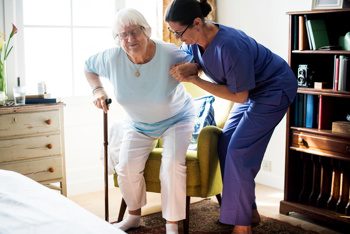
Elderly fall prevention
Falls prevention in the elderly should be a priority in any care organisation looking after older people. According to a survey commissioned by Age UK, 36% of older people cited falling as their greatest concern. Fortunately, falls can be prevented and should not be seen as inevitable among older people.
Reducing the risk of falling has wider benefits beyond falls prevention such as improved physical and mental health, and enhanced overall quality of life.
Fall prevention in older adults requires a two-pronged approach: individual risk assessment followed by appropriate interventions.
Risk assessment
Preventing falls in the elderly should start with a multifactorial risk assessment. When all potential causes of falls have been identified, a person’s risk of falling can be determined. Risk assessments should be performed from the outset to identify all contributing factors.
The risk assessment should cover the following domains:
Mobility
- Balance: Screen for balance disorders using the Single Leg Stance (SLS) test.
- Gait: Assess gait using the Functional Gait Assessment.
- Muscle strength: Screen for muscle weakness using Muscle Strength Testing.
- Footwear: Screen for potential inappropriate footwear.
- Fear of falling: Assess fear of falling using the Falls Efficacy Scale.
Activities of daily living
- Functional ability: Assess ability to carry out Activities of Daily Living (ADLs).
Cognitive function
- Cognition: Screen for cognitive disorders using the Montreal Cognitive Assessment (MoCA).
- Delirium: Assess presence of delirium, using the Delirium Assessment Tool (4AT)
Autonomic function
- Orthostatic hypotension: Measure blood pressure when lying on their back and then upon standing.
- Urinary incontinence: Assess with 3IQ screening test.
Disease history
- Cardiovascular disorders: Assess with focused cardiovascular physical examination.
- Contributing diseases: Assess for acute conditions such as pneumonia.
- Parkinson’s disease: Assess mobility, cognition, and orthostatic hypotension.
- Depressive disorders: Screen for depressive disorder using the Geriatric Depression Scale (GDS).
Medication history
- Medication: Review all prescribed fall-risk-increasing drugs (FRIDs).
Nutrition history
- Nutritional status: Screen for malnutrition using the Malnutrition Universal Screening Tool (MUST).
- Vitamin D: Screen for vitamin D deficiency and remedy with supplementation.
Environmental risk
- Environment: Assess for hazards using the Westmead Home Safety Assessment.
Interventions
Falls prevention requires a multifaceted approach to interventions. Elderly persons benefit the most from multidomain interventions based on their individual risk assessment. Physical restraints are not recommended and should be avoided.
Interventions should cover the following domains:
Mobility
- Exercise programs including Tai Chi, balance and resistance training.
- Mobility programs including standing, walking, and climbing stairs.
- Physiotherapist consultations for tailored advice
Cognitive function
- Cognitive behavioural therapy to reduce fear of falling.
Disease
- Management of orthostatic hypotension.
- Management of cardiovascular disorders.
Medication
- Deprescribe fall-risk-increasing drugs (FRIDs) using STOPPFall.
Nutrition
- Nutritional optimisation focusing on calcium, protein, and vitamin D.
Environmental
- Care staff training in falls prevention.
- Environmental modifications to reduce hazards.
Fall prevention strategies
Fall prevention strategies cover much more than interventions to prevent falls. They are part of a broader context that supports active living to improve the quality of life for older people. This means thinking about what it means to age well while staying healthy, safe, and connected.
The fundamentals of any strategy for the prevention of falls are:
- Promoting healthy lifestyles that contribute to healthy aging.
- Keeping elderly people engaged with family and social networks.
- Integrating falls prevention training into community and social care.
A strategy to prevent falls can be broken down to a series of simple actions:
- Exercise to improve balance: Muscle strength and balance tend to diminish with age, making older people more susceptible to falling. Appropriate exercises can be used strengthen muscles and improve balance.
- Support bone health: Strong bones not only make a fall less likely but also reduce the risk of severe injury if a fall occurs. Regular exercise coupled with a diet rich in calcium and vitamin D will fortify bones. Calcium can be obtained from dairy products. Vitamin D can be obtained from oily fish, eggs, sunshine and supplements.
- Stay hydrated: Drinking 6 to 8 glasses of fluids a day prevents feelings of light-headedness or dizziness due to dehydration, which can increase the risk of a fall.
- Cut down on caffeine: A recent study by Care England found that switching to decaffeinated hot drinks cut down falls in care homes by 35% through reducing the urge to rush to the toilet.
- Manage health conditions: Low blood pressure and diabetes can make people feel faint or dizzy. These conditions must be properly managed with the assistance of health professionals.
- Review medications: Certain medications or combinations of medications can make people feel dizzy and affect their balance. GPs can advise on reducing the dose or using alternatives. Be aware that some medications, when combined with alcohol, will impair balance.
- Have regular eyesight tests: Eye tests should be conducted least every two years as poor vision can lead to a trip or a loss of balance. Eye conditions such as macular degeneration, glaucoma and cataracts are associated with aging and need to be detected at an early stage.
- Have regular hearing tests: Ear problems can affect balance and GPs should be consulted if there are any changes in hearing. In many cases the problems can be easily treated, for example a build-up of ear wax or an ear infection.
- Choose the right footwear: Footwear should have low heels, good grip, and fit securely, to improve balance and reduce the risk of tripping. Footwear solutions can include fall prevention shoes, fall prevention slippers, and fall prevention socks.
- Make homes fall-proof: Keep stairs and hallways free from objects, like trailing wires or fraying rugs, that could cause someone to trip. Bedrails for fall prevention can be installed to prevent people from falling out of bed.

Fall prevention program
To be effective, a fall prevention program must be closely tailored to the needs and preferences of the person. Older adults can be categorised according to their level of risk of falling: low risk, intermediate risk, and high risk. There are separate programs for each level of risk.
Programs for low fall risk
Education
- How to maintain safe mobility and optimise physical function.
- Awareness of fall prevention guidelines.
- Better nutrition, physical activity, and lifestyle habits.
Interventions
- 150-300 minutes per week of intermediate-intensity physical activity or 75-150 minutes per week of vigorous-intensity physical activity.
- Coaching, supervision, or group classes to encourage adherence to the physical activity regime.
- Periodic vision and hearing checks.
- Regular foot care.
- Referral to local community ‘ageing well’ programs where available.
- Fracture risk management (including treatment for osteoporosis).
The physical activity recommendations are taken from the UK Physical Activity guidelines.
Programs for intermediate fall risk
Interventions
- Supervised balance and strength exercises focused on training functional tasks needed for daily living.
- Supporting exercises including sit-to-stand, squats, reaching while standing, standing on a narrower surface, walking in different directions, walking while multi-tasking.
- Weighted versions of supporting exercises for increased difficulty.
Exercises should be challenging but safe and reviewed regularly to ensure the optimal level of difficulty is maintained.
Programs for high fall risk
Recommendations
- Holistic multifactorial falls risk assessment. This requires a full clinical assessment combined with an evaluation of the elderly person’s needs and the resources available.
- Personalised care plan developed to prevent falls designed with the involvement and training of carers.
- Full engagement of the elderly person who should be empowered to make an informed choice about participating in the program.
Interventions
- Strength and balance exercises.
- Medication review.
- Management of orthostatic hypotension and cardiovascular diseases.
- Management of underlying acute and chronic diseases.
- Optimising vision (including cataract surgery where needed) and hearing.
- Addressing foot problems and appropriate footwear.
- Vitamin D supplementation.
- Optimising nutrition.
- Continence management.
- Interventions to address concerns about falling.
- Individual education.
- Environmental modification including assisted devices and use of technology.
Two common exercise programs for high fall risk people are Otago (OEP) and FaME (Falls Management Exercise). Both programs have been rigorously tested and proven to work.
Fall prevention exercises
Fall prevention exercises are essential to all fall prevention programs. Trials of exercise programs have reduced the incidence of falls by as much as 31%. An important message is that exercise isn’t just about preventing falls. Exercise can also be about having fun and staying connected.
The most important criteria for prescribing fall prevention exercises are:
- Exercises must focus on strengthening leg and ankle muscles and challenging balance. This means that chair-based exercise and seated gym machines have limited value.
- Exercise frequency should be one hour of exercise three times a week.
- Exercises should be professionally programmed to pose the appropriate level of challenge to the individual.
- Supplementary activities that have proven effective include Tai Chi, dancing and gardening.
Mike Kutcher, a Seniors’ Specialist Physiotherapist and Exercise Scientist, recommends the following 10 exercises to prevent falls:
- Knee Extensions
- Sit-To-Stands
- Calf Raises
- Partial Squats
- Knee Flexions
- Hip Extensions
- Hip Abductions
- Static Balance
- Heel – Toe Walks
- Figure 8 Walks
Fall detection technology
Fall detection technology offers a simple and cost-effective way of preventing falls. The technology comes in many forms, including video analysis, alarm technology, data analytics, and wearable sensors. Implementing these technologies can improve fall prevention through greater efficiency, access, and reliability.
Most fall detection tools rely on tracking a person’s motor activity using one or more sensors. These sensors translate physical movement into data that can be analysed.
There are two types of systems that help with the detection and prevention of falls:
- Wearable systems: Wearable devices such as watches, pendants and badges can be equipped with sensors that track a person’s movement.
- Nonwearable systems: Sensors positioned around a person’s environment can be used to track a person’s movement through the environment.
Although they may be considered a minor inconvenience for the user, wearable systems are more effective than nonwearable ones for two reasons: they can detect changes with higher accuracy, and they do not require the person to be in a specific area to be effective.
Fall prevention wearable devices
Fall prevention wearable devices are simple and easy to use, offering a practical and effective solution to fall prevention. Older people can be reluctant to adopt new, unfamiliar technologies. Fortunately, wearable devices are unobtrusive and unintimidating, making them ideal for elderly care.
At Access, we have been offering software solutions to care providers for more than 30 years. We support over 6,000 care homes and over 4,500 community agencies.
Our technology enabled care (TEC) solutions include:
- Personal alarms which are discrete and wearable devices that send alerts to a chosen contact to attend the elderly person in the event of an incident.
- Home sensors identifying behaviours that could indicate a higher risk of falls. For example, people moving less can be a sign of inactivity, and people turning on the kettle less can be a sign of dehydration.
- Access Device Management Platform allowing carers to gain insight to the behaviours of people in their care to help prevent falls
By identifying potential causes of falls at an early stage, proactive action can be taken.
To find out about the technology enabled care (TEC) we offer at Access, contact us here to discuss your needs or to book a demo.

